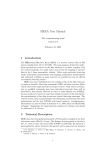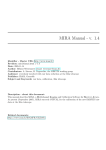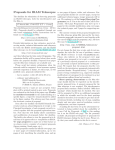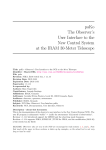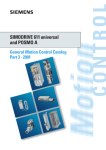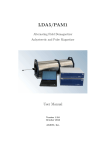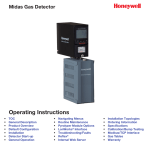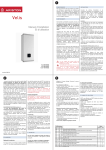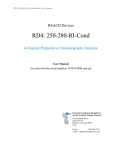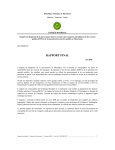Download HERA User Manual
Transcript
HERA User Manual The commissioning team∗ version 2.0 November 18, 2009 1 Introduction The HEterodyne Receiver Array HERA is a receiver system with 18 SIS mixers tunable from 215 to 272 GHz arranged in a 3x3 dual polarisation pixel pattern. The main purpose of this first multi–beam spectral line receiver on the 30m telescope is to allow, together with the related backends, for rapid raster and on–the–fly imaging of spectral lines in the 1.3mm atmospheric window. Other more particular observing modes (continuum measurements and mapping, polarisation measurements and optimised wobbling on point sources) are possible but not yet offered as standard observing modes. 1 HERA has been embedded into the existing setup of the 30m telescope as much as possible. Observing commands (PAKO) and data structure follow closely that of the single pixel spectroscopy receivers. Only where necessary, new or modified commands have been introduced and only these will be described in this manual. However in order to make efficient use of HERA, the user needs to be aware of some basic technical aspects of the instrument, the particularities of the data stream and typical observing strategies. The current version of the manual includes the description of observing with both polarisations and the new WILMA wide band correlator. Complementary information can also be found in Schuster et al. 2004 A&A (see IRAM 30m web page). Suggestions for improving this manual are welcome and should be addressed to A. Sievers. 2 Technical Description HERA has nine dual polarisation pixels (18 Channels) arranged in the form of a square center–filled 3×3 array. The distance between pixels on the sky is 24′′ , i.e. close to twice the beam width (FWHP) at 230 GHz. By means of a quasi-optical K–mirror derotator this pattern can be placed at any position angle on the sky (see also sect. 4). The two polarisation modules are named ∗ ) K. Schuster, A. Greve, P. Hily–Blant, P. Planesas, A. Sievers, C. Thum, and H. Wiesemeyer 1 contact A. Sievers, C. Thum or K. Schuster 1 Figure 1: Optical layout of HERA, including the derotator. HERA1 and HERA2. Each module can independently be tuned to different sky frequencies and be attached to different backends. 2.1 Cryogenics HERA is cooled with a 3 stage closed cycle refrigerator system (DAIKIN) which greatly reduced technical overhead times and running costs. The receiver can be warmed up in 12 hours and be cooled down within 36 hours. Usually the receiver is kept cold for periods of at least 3 months followed by a maintenance period of typically 4-5 days. 2.2 Optics HERAs optics (fig. 1) is designed to give maximum point source coupling of the individual beams and at the same time to reduce deformations of the array geometry irrespectively of the position of the K–mirror derotator. With this concept it is possible to obtain extremely simple observation procedures as it is not necessary to make field maps for calibration of the array parameters or other particular measurements before mapping. The positions of the elements are simple functions of the position of the central elements and the chosen derotation angle. The optics of HERA is largely reflective which reduces baseline ripples due to standing waves by a large amount. 2.3 Optical data and efficiencies An internal cold/hot load system is integrated into HERA and allows to calibrate all 18 channels in a single hot/cold load procedure. Due to its dual polarisation and derotation concept HERA cannot be combined with other receivers. Switching between HERA and other receivers is however possible 2 within about 10 minutes. HERA1 pixels have vertical (in the Nasmyth cabin) polarisation and share the same local oscillator. They have thus the same sky frequency. HERA2 has horizontal polarisation and a different LO, its nine pixels can thus be tuned to a sky frequency, different from that of the vertical pixels. The relative pointing of the two polarisation modules is better than 1.2”. Both modules share the same focus setting. The efficiency related parameters near 230 GHz are : effective cold load temperature conversion factor from measured to effective cold load temp. image band gain forward efficiency main beam efficiency Beam size at 230 GHz 2.4 ∼ 97 K ∼ 0.8 ∼ 0.1 Feff = 0.90 Beff = 0.52 11.7′′ Derotator The derotator is an optical ensemble in front of the HERA cryostat (Fig. 1 which allows to compensate for the rotation of the astronomical object in the focal plane of the telescope. This rotation is due to the general characteristics of an AZ-Alt-mounted Nasmyth-telescope and a function of actual Azimuth and Elevation. The derotator compensates this rotation by computer controlled movements. The end-effect is, that the pixel pattern (and polarisation) can be kept fixed on the sky (in the equatorial system or alternatively in the horizontal system). Fields can therefore be easily sampled homogeneously and a great number of particular observing strategies are possible. The derotator is constructed as a K-mirror, a device, although frequently used in optical astronomy, has never been implemented in the millimiter range before HERA. To make efficient use of HERA it is essential that the observer understands the possibilities available with the derotator before observing. The current control software allows to keep the HERA pixel pattern stationary, i.e. derotate various hour angle dependent rotations, in the following three coordinate systems. F Frame Nasmyth coord. H Horizontal Az., El. Syst. S RA, Dec. Syst Sky similar to Bolometer (stationary in the receiver cabin) useful to align array with chopping direction most common mode The derotator is controlled from PAKO by entering, PAKO> receiver hera1 /derot β S where S makes the derotator tracking the sky rotation and β is the position 3 angle (constant in time) by which the HERA pixel pattern is rotated with respect to the equatorial system (counting east from north). The derotator command is executed when a “LOAD” is made in the telescope control or in other words before a new scan is started. As an example, commanding β = 0◦ . keeps the 9 pixel pattern of HERA stationary in the equatorial system so that the horizontal rows of 3 pixels (e.g. pixels No. 1, 4 , and 7) are always parallel to right ascension, like shown in Fig. 4. In this seemingly simple setup the HERA center pixel (No. 5 in Fig. 4) is on the telescope’s pointing axis, and all peripheral pixels have fixed (in time) offsets in the equatorial system of ∆α and ∆δ of 0′′ or ±24′′ according to Fig. 4. The angle by which the derotator can be physically rotated in the frame system is limited to ±83◦ . As the K-mirror multiplies rotation angles by a factor of two this allows to rotate the pixel pattern on the sky within a range of 332◦ . However while tracking it might happen that the derotator approaches these physical limits, particularly for sources close to the zenith. To avoid loss off data the observer should keep an eye on the newly installed HERA monitor web page (ask the operator or the AOD to open this web page in the automatic update mode within the screen ensemble of the observer). The current angle and tracking system is displayed in the left upper corner of this web page. When the DEROTATOR box is turning yellow the derotator is still tracking normally but its time for action. If it turns red, tracking is off due to the mechanical limits. Mapping part of an extended source with the derotator stuck in a limit may result in un-reproducible distortions. If the derotator angle displayed in the derotator window is close to a limit (yellow), the derotator should be rotated by 90◦ (Sky system) in the right direction. If the limit at −84◦ is approached, set the angle to β − 90◦ where β is the angle demanded by the mapping mode (see below). A procedure is implemented in MIRA which generates a plot of the derotator angle in the frame system as a function of time UT. Briefly the procedure is as follows: Read in an Hera-observation of the source you are observing and obtain a plot using MIRA> view /derotator For further details type ’help view’ in MIRA. 2.5 Mixers and RF performance HERA uses waveguide SIS mixers which can be tuned in LSB or DSB mode. The coupling of local oscillator power is obtained over waveguide coupler modules. LSB is the normal and preferred tuning mode as it offers superior overall system noise. However it must be recognised that LSB tuning results frequently in reduced total power stability which sometimes makes pointing on weak sources difficult. The noise performance of HERA1 over the tuning range is given by Fig. 2. HERA2 has a very similar performance for frequencies up to 230 GHz but is 4 Figure 2: SSB receiver noise temperatures across the tuning range. These temperatures were measured in the laboratory in front of the dewar window. higher in noise above 230 GHz. In practice, these noise temperatures have to be increased by a factor of 1.15 if VESPA is used as the backend (IRAM’s correlators are presently 2 bit 4 level). Another small increase (3. . . 5 K) comes from losses on the derotator mirrors. It is planned to upgrade the mixers of HERA in the future. The local oscillator tuning range is 219 to 274 GHz. Taking the IF frequency of 4 GHz into account, this results in a RF tuning range of 215 to 270 GHz for LSB tuning (standard tuning mode). DSB tuning is also possible. The IF bandwidth is 1 GHz. Tuning is automatic and uses look– up tables. Because these look-up tables have not yet been finalised the tuning has to be prepared in advance, apart from a series of heavily used frequencies. 2 The image rejection is about 10 dB in LSB tuning mode for all pixels (gi = 0.1) and set globally for both modules at the present time. A more precise rejection measurement using a line injection device is currently being developed and will ultimately allow to retrieve individual rejections for each pixel from a look-up table at each frequency. The limited accuracy of the knowledge of sideband rejection leads to relative calibration errors in the range of 0-10% . For high signal to noise mapping it is therefore recommended to undertake some additional steps for relative calibration or “flatfielding” (see Sect XX). 2 See Appendix B for a look-up table of sky frequencies. 5 3 Basic calibration observations This section describes the basic observations which serve to measure the telescope pointing and focus and to calibrate the antenna temperature scale. The HERA pixel pattern is shown in Fig. 3 as it appears in the receiver cabin (Nasmyth coordinations) before rotation in the derotator assembly (see sect. 2.4), when looking towards the subreflector. 3.1 Pointing Pointing with the central pixel. The central pixels of HERA1, No. 5, and of HERA2, No. 5, are aligned with the telescope’s pointing axis and with the other SIS receivers to within better than ≤ 2′′ . This degree of alignment was measured to be independent of the actual derotator position. For pointing with central pixels it is therefore not necessary to set a particular derotator angle or tracking system and the standard pointing model can be used unmodified for HERA. Default pointing scans are made with the central pixel of HERA1 and HERA1 and the command: PAKO> pointing PAKO> start Information on which pixel to ’solve’ for pointing is not yet passed to the data reduction (MIRA). But pointings can be ’solved’ in MIRA (for any pixel) as follows: MIRA> solve 2 /pixel 5 Here we assume that HERA2 is connected to the second part of the CONTINUUM backend. Pixel 5 is the default. The resulting correction parameters can be taken into account by the command: PAKO> set pointing dAzm dElv Pointing with off-center pixels. Although somewhat more complicated, pointing with HERA is possible also with offset pixels, described by their offsets xn , yn in arc sec (see Tab. 1) The results are always referred to the position of the central beam. This option may be used if an off–pixel has a much better continuum sensitivity or stability than the central pixel. Right now a few commands have to be entered in PAKO to make pointings with off–elements: PAKO> receiver hera1 /derot 0 F PAKO> offsets xn yn /SYSTEM Nasmyth PAKO> pointing 6 PAKO> start PAKO> offsets /clear To get the result of the pointing in MIRA MIRA> solve 1 /pixel n or MIRA> solve 2 /pixel n The first command sets the derotator to zero degrees, its default position (no rotation) in the Nasmyth cabin. Next, PAKO is informed about the offset in Nasmyth coordinates of the receiver (pixel) used for pointing. Fig. 3 and Tab. 1 show the correspondence between pixel No. n and their offsets H and V in Nasmyth coordinates, Note: The arguments xn , yn of the PAKO offsets command have the opposite signs, as these arguments are offsets for the telescope pointing which bring off–pixel n back onto the pointing axis. The designation of the pixels in spectroscopic data is described below. The nominal offsets of the pixels as given in Tab. 1 have been determined from beam maps and are valid to a precision of better than 1′′ . In the horizontal system, the Nasmyth pixel pattern is rotated by the elevation angle. In the equatorial system, an additional rotation by the parallactic angle is made. Table 1: HERA pixel pattern and corresponding spectrometer sections. HERA1 pixel No. 1 2 3 4 5 6 7 8 9 HERA2 pixel No. 1 2 3 4 5 6 7 8 9 Nasmyth offsets offsets H V −24 −24 −24 0 −24 0 +24 −24 0 0 xn +24 +24 +24 0 0 yn +24 0 −24 24 0 1H01 2H01 1H01 2H01 1H01 2H01 1H02 2H02 1H02 2H02 1H02 2H02 1H03 2H03 1H03 2H03 1H03 2H03 1H04 2H04 1H04 2H04 1H04 2H04 1H05 2H05 1H05 2H05 1H05 2H05 spectrometers VESPA V0(1 ... 4) WILMA W01 WILMA W02 filterbank 4MHERA1 filterbank 4MHERA2 3.2 0 +24 +24 +24 +24 −24 0 +24 0 −24 −24 −24 −24 +24 1H06 2H06 1H06 2H06 1H06 2H06 1H07 2H07 1H07 2H07 1H07 2H07 0 −24 1H08 2H08 1H08 2H08 1H08 2H08 1H09 2H09 1H09 2H09 1H09 2H09 Focus HERA’s derotator re–images the telescope focal plane which is located about 28 cm in front of the derotator rotation axis, onto the dewar window. The 7 Figure 3: HERA beam pattern at the telescope focal plane in the Nasmyth cabin, viewed from the receiver. The derotator is at its default position (derot 0 F). This is not the sky pattern ! separation between the HERA mixers and the subreflector is therefore considerably longer than for the other SIS receivers. Nevertheless, HERA was installed in such a way that its telescope focus setting of the secondary mirror is within 0.5 mm of that of the other receivers. The possibilities to focus HERA are quite similar to the pointing options. There is no difference to single beam receivers for focusing onto the central element, and one uses the PAKO command offsets to focus on off–elements. To focus on off–center pixel No. n, e.g. because it is more stable in continuum than the center pixel, one goes through the following sequence of PAKO commands: PAKO> receiver hera1 /derot 0 F PAKO> offsets xn yn /SYSTEM Nasmyth PAKO> focus PAKO> start PAKO> offsets /clear To get the result of the pointing in MIRA MIRA> solve 1 /pixel n 8 or MIRA> solve 2 /pixel n Remark: The focus procedure of the 30m telescope has shown some odds recently. It is not unusual to have from time to time unsatisfactory focus fits which would result in very big offsets. HERA has been proven to focus very closely to the position of the other SIS receivers. Do not simply correct for proposed focus offsets of more than 2mm, but double check these results with another focus observation. 3.3 Calibration For HERA a specific calibration system is used, consisting of dedicated hot and cold loads. The cold load is integrated into the cryostat of HERA. For the observer however this is transparent, as the PAKO command calibration is redirected to control the HERA calibration system. The only difference is that the cold load temperature may change slightly in time. Because of this the temperature of the cold load is measured and displayed in the monitor window that also displays the derotator angles. At present (NCS) the effective cold load temperature and also the hot load temperature read from the calibration system, are written to the raw-data (IMBFits) files. The values that the observer sets in PAKO are only used if no other values could be found. The observer can set these values for HERA1 and HERA2 in PAKO with the usual command: PAKO> receiver hera1(2) /tempLoad Tcold-eff Thot The image rejection is about 10dB in LSB tuning mode for all pixels (Gni = 0.1 for LSB and 1 for DSB tuning) and set globally for all pixels of a module at the present time. PAKO> receiver hera1(2) /gain -10 db Right now the limited precision of the image rejection factors Gni , is the largest source of calibration errors. The limited accuracy of the knowledge of sideband rejection leads to relative calibration errors in the range of 010% . For high signal to noise mapping it is therefore recommended to undertake some additional steps for relative calibration or “flat-fielding” (see Sect XX). A more precise rejection measurement using a line injection device is currently being developed and will ultimately allow to retrieve individual rejections for each pixel from a look-up table at each frequency. 4 Spectroscopic observing modes As HERA is a heterodyne receiver, we describe here only spectral line observing modes, although continuum mapping is possible (see section 5). In a first step the basic observing modes are described and then we explain how the various backends can be attached. Please consider that due to certain 9 Figure 4: HERA beam pattern on the sky when set to track the rotation of the equatorial system with zero offset angle (PAKO> receiver hera1 /derot 0 S). The correspondence between pixel numbers and spectrometer sections is described in Tab. 1. constraints (mainly computer limitations), observing modes and possible backend combinations are not independent. • single stamps (section 4.2), take nine point maps with a single integration, not fully sampled. • raster maps, i.e. observations where the telescope steps through a series of points (usually fixed in the equatorial system), at each of which the telescope dwells for some integration time. • on-the-fly maps, i.e. observations where data are taken while the telescope moves at constant velocity along a linear path in the equatorial system. The upgraded web–based time estimator (version 2.5 and higher) handles these modes in an approximate way. Simple integrations on point sources are also possible. 10 Figure 5: Wobbler–switching with HERA. Right frame: A linear sequence of pixels is considered, the center one of which is located on the pointing axis of the telescope pointed at a source. When the wobbler is switched on (wobbler throw is equal to the pixel separation) 4 beams are generated on the sky. Plus and minus signs after the pixel number indicate the polarity of the wobbler phases (negative ones are outlined in dashed lines). Left frame: Observation of an extended source, IRC+10216, in 12 CO(2–1). System temperatures are below 300 K, integration time is 2 min. Apart from the usual signal in the center pixel, two peripheral pixels detect a negative signal at the level of about 50%. Horizontal scales (LSR velocity, km/s) and vertical scale (antenna temperature, K) are identical for all pixels (number in the upper right corner of each spectrum). 4.1 General aspects 4.2 Single Stamps and Observations of Point sources The very basic observations are single integrations with a fixed position on the sky. This will result in 18 spectra on nine position of the sky (see Fig. 4). If requested the pattern can be turned around the central pixel with the help of the derotator command. Before starting large maps it is always recommended to do such a single shot in order to make sure that the system has been set up properly. The pattern can also be offset from the pointing center by the usual commands of PAKO. If observed with the derotator tracking in the sky system the spectra will be written with the correct offsets into the spectra.30m file. The use of an array receiver offers also a certain signal–to–noise advantage compared to single pixel receivers. So far we tested several wobbler switching schemes where the source was observed more efficiently than in the 50% available with the standard wobbler switching mode. The aim was to combine the increased switching efficiency available with the array with the optimum baseline quality inherent in the standard wobbler–switched mode. Our most successful schema is outlined in Fig. 5. A linear sequence of pixels is aligned with the horizontal direction in which the subreflector 11 was wobbling.√The wobbler throw is set equal to the pixel separation (usually 24”, but 2 × 24′′ when a diagonal pixel sequence is chosen), and the derotator is commanded as PAKO>receiver hera1 /derot −45 H The standard ’onoff’ command of PAKO then executes two observations with telescope offsets of ±throw/2. The schema shows that pixel 2 sees the source in each observation for 50% of the time exactly as in standard wobbler switching with a single pixel receiver. Additionally, HERA pixels No. 1 and 3 are also looking at the source, but only during one of their phases. Since the wobbler–switched signal is the difference between the two observations, pixels No. 1 and 3 register the source signal at a level of −50%. Averaging the signals from the three pixels with their right polarity therefore increases the signal–to–noise ratio by √23 over the standard wobbler–switching.3 In our particular observation (Fig. 5) weak signals are also detected in other pixels demonstrating that the source is actually extended. The spectroscopic baseline is flat in all pixels, no deterioration was detected compared to the standard wobbler–switching with a single pixel receiver. In a more severe test, a long integration of a CO transition in a z = 2.2 source was made. The baselines were again flat and the line was detected. Other wobbler switching schemes were tried where the full signal amplitude was obtained not only for pixel 1, but also for pixels 2 and 9. The S/N improvement in these more complicated schemes were however less than in the scheme described above (they would become more interesting with larger arrays). position switching. The raster map procedure asks for the position offset of the reference position with respect to the map center. It is possible to do several ON source observations per reference observation. This saves observing time, but was found to easily introduce poorer baselines. (Note that HERA operates at 1.3mm wavelength) wobbler switching. This mode gives the best baselines on the 30m. As the wobbler throw is at maximum 240′′ , map and source size must be matched carefully if the reference beams are to be kept free of signal. Note that contrary to position switching the position of reference beams refer to the current raster point (not the map center) and rotate with respect to the source. frequency switching. For many extended sources, wobbler and even position switching may not be adequate, and only frequency switching may be practical. Owing to its position in the Nasmyth cabin, HERA has the cleanest optical path of all 30m receivers. Its frequency baselines are found to be the best recorded so far. A ripple at 6.9 MHz, probably originating from reflections between the subreflector and the mixers, dominates the spectroscopic baseline. Flat baselines are obtained by setting the frequency throw equal to this value or multiples of it. Satisfactory performance was obtained up to throws of 6 × 6.9 MHz (54 km/sec). 3 Compared√ to single pixel wobbler switching the signal is doubled and the noise is increased by 3. This S/N ratio increase of ∼ 15% is improved to ∼ 22% if optimum weights are used when averaging the spectra ( 41 , 12 , 14 ) from the three pixels. 12 Figure 6: Orientation of the HERA pixel pattern used in the coarsely sampling OTF mapping mode. The pixel pattern is rotated by χ = 18.5◦ in the equatorial system. This results in a uniform OTF map where the scanning lines (parallel to right ascension) are separated in declination by ∆s = 7.6′′ . If uniform coverage is to be extended toward the north, a second map is made with a declination offset of ∆δ = 9 × ∆s = 68′′ . Frequency switching rates up to 10 Hz were successfully tested with both HERA modules connected to the VESPA backend (sect. 4.1 and Tab. 3) used with 80 kHz resolution and 40 MHz bandwidth, i.e. 50% usage of VESPA capacity. However, there is usually no need with the raster-map procedure to switch faster than about 1 Hz. 4.3 On–the–fly maps OTF mapping, the most powerful spectroscopic mapping mode on the 30m, becomes even more powerful with HERA. So far, we have expanded on the single receiver OTF in the following two ways: • scanning procedures, some with special orientations of the HERA beam pattern, reduce the time for mapping by factors somewhere between 3 and 9. • frequency switching is possible with the VESPA backend, eliminating the need for reference observations. 13 Scanning procedures. We support the following three scanning procedures, i.e. observing procedures exist, data reduction is tested, and they are handled by the web–based time estimator (version 2.4 and higher). These three scanning procedures are associated with different orientations of the beam pattern (rotation angle χ) with respect to the scanning line (taken here as right ascension). ⋄ zero rotation (labeled in the Time Estimator: SL–OTF, not inclined) ⋄ coarse sampling (SL–OTF,8 arc sec) ⋄ oversampling (SL–OTF, 4 arc sec) In the zero rotation mode, the beam pattern is scanned parallel to right ascension like in Fig. 4. The points on each of the 3 scan lines are sampled three times, but the area between the three horizontal beam rows is not sampled. This mode may be useful for obtaining a first quick look on a weak extended source. In the coarse sampling mode, the beam pattern is rotated by χ = 18.5◦ . This results in a slightly under-sampled map where the scan lines are separated by ∆s = 7.6′′ (Fig. 6). The map is homogeneously sampled apart from 60′′ wide vertical margins at the left and right ends of the scanning lines. In the oversampled mode, the beam pattern is rotated by χ = 9.5◦ . This generates three bundles of three scan lines spaced by ∆s = 3.9′′ , the separation between the bundles being ∆δ = 3 × ∆s. Two OTF scans must therefore be made (see Fig. 7) which are offset by ∆δ in declination. The scan direction of these two OTF scans may be the same, as shown in the figure, or opposite to each other. At the end, a homogeneously sampled map is obtained again, apart from 56′′ wide lateral margins. Note that for maps smaller than typically 2′ on a side, the size of these margins are a large fraction of the total area to be mapped. Such small maps are therefore more efficiently done in raster mode. Total power OTF is available with VESPA, WILMA and the filter spectrometers. Observations with the 4 MHz filterbank clearly demonstrate the sensitivity of this observing mode to sky noise and gain variations in the receiver. Together with the unavoidable nonlinearities of the backends, sky noise and receiver gain variations lead to base line distortions and (for the correlators) to platforming. Good and stable weather conditions are therefore mandatory for this observing mode.. The gain drifts are related to the temperature fluctuation of the cryostat which has an irregular cycle period of 3 to 5 min and sometimes intrinsic mixer instabilities. Under good weather conditions (Tsys ∼ 300 K) the drifts which may be as rapid as a few seconds reach amplitudes of 0.2 K. The gain drifts affect different sections of the bandpass differently, and are statistically less severe near the times when a reference observation is made. Software is being developed to correct for the gain drift induced baseline variations. The mainly concerned extra-galactic observers are invited to contact H. Wiesemeyer ( [email protected]). about what is currently possible. Furthermore, the physical temperature of the mixers are monitored 14 Figure 7: Orientation of the HERA pixel pattern used in the oversampling OTF mapping mode. The pixel pattern is rotated by χ = 9.5◦ in the equatorial system. Two OTF scans are made separated by ∆δ = 3 × ∆s = 12′′ in declination. A second pair of such maps (not shown), offset in declination by 6 × ∆δ = 71′′ , extends uniform coverage to the north. and written to the Raw data (IMBFits) and can be used to re–calibrate the receiver gain. Frequency switched OTF is available with the same hardware limitations as with rasters (sect. ??). A high (> 1 Hz) frequency switching rate is however more important here than with rasters. 4.4 Ugly details The procedures described in this manual do not exist yet for the NCS. No Backend pre-integration done in the NCS (yet!). So with fast i.e. 10 Hz Frequency switching the raw data file tend to get very large and the data calibration in MIRA impossible slow! So for the time being observers are advised to ’switch as slow as possible’ i.g. use 0.5 Hz Frequency switching when the intended sampling of the sky is 2 seconds. 15 Figure 8: A rotated coordinate system is illustrated with an outflow source centered on the star (∗) which is located at α0 , δ0 in the equatorial system. The new coordinate system has its equator, λ, aligned with the outflow lobes, and the orgin of the new system is at the star. The latitude, β, makes an angle κ with the local meridian. 4.5 4.5.1 Special Observing Modes Rotated coordinate systems OTF mapping in coordinates other than the equatorial system are also possible in the future, but are not needed anymore to aligne a map with the plane of a galaxie or a molecular outflow. A OTF map can now be scanned along inclined scanlines, i.e. scanning both in x and y. The following discussion does also apply in this case, where κ is the angle between the scanning direction and equator. In such a system, rotated by the angle κ relative to the equatorial system, the derotator has to be given the same additional angular offset. The corresponding PAKO command would be PAKO> receiver hera1 /derot χ−κ S where χ is as above the angle induced by the OTF mapping mode. This situation is depicted in Fig. 8 where the array scans along the λ axis of a descriptive system centred at (α0 , δ0 ) and tilted by the angle κ with respect to the local meridian. Change of your observations into a rotated coordinate system is foreseen in PAKO but not yet tested. 16 4.5.2 Backends HERA as a general purpose multi–beam receiver has strong demands on spectral backends. Tab. 2 lists the available backends. type 4MHz FB VESPA WILMA Table 2: Backends for HERA channel spacing bandwidth number kHz MHz of units 4000 20 – 1250 2000 1024 20 – 640 930 9 9 – 36 18 status available available available The filterbank consists of 9 units with 256 channels each. The channels have a half-power width (resolution) of ca. 5 MHz, corresponding to a noise–equivalent bandwidth of 6.4 MHz. Channel spacing is 4 MHz. The 9 units were successfully taken into operation in February 2003. The PAKO command for setting up the filterbank is PAKO> backend 4MHz 1 /Receiver HERA1 or HERA2 The uncalibrated raw data are written to a LINUX computer. An automatic calibration task generates a spectra.30m file which can be analysed with CLASS. The 4 MHz data are identified by their “set telescope” name. The central pixel, e.g., is designated as 30M-4M1-1H05. The digital correlator VESPA offers spectral resolutions in the range 20 - 1250 kHz (Tab. 3). Up to 4 spectral bands per pixel are available for the current 9+9–pixel array. The 4 bands can be placed anywhere in the lower half of the 1 GHz wide IF range. Remember to configure the receivers in ”narrow” mode when using Vespa. A typical PAKO command for setting up the correlator is PAKO> receiver VESPA 1 0.320 160 0.0 /Receiver HERA1 or HERA2 where one section of VESPA is connected to each HERA pixel. Each section has a channel spacing of 320 kHz, 160 MHz of nominal bandwidth, and an offset of zero (in MHz) from the IF center. This configuration uses 50% of VESPA hardware, so that more sections could be connected, possibly at off–center frequencies. The calibrated HERA spectra are identified in CLASS by their “set telescope” name. The central pixel, e.g., is designated as 30M-V01-2H05 where V01 stands for the first frequency band connected and 2H05 stands for pixel No. 5 of HERA2. (see also Tab. 1). The new correlator is now the wide band (usable bandwidth 18 x 930 MHz) WILMA backend offering 9 + 9 spectral bands. The setup in PAKO is simple, the following PAKO> backend WILMA 1 /Receiver HERA1 or HERA2 sets the first 9 spectral bands, and PAKO> backend WILMA 2 /Receiver HERA1 or HERA2 sets the second 9 spectral bands. The distribution of the 4MHz and WILMA backends and HERA1 and 17 HERA2 is now done automatically by a new ’distribution box’. Only the 4MHz has to be switched manually between single pixel receivers and HERA. Table 3: VESPA configuration table. channel spacing kHz 1250 1250 1250 1250 320 320 320 320 80 80 80 80 40 40 40 40 20 20 5 bandwidth, MHz nominal actual 160 320 480 640 80 160 240 320 40 80 120 160 20 40 60 20 20 40 number of channels raw data RED calibrated 141.2 281.2 421.2 511.2 70.3 140.3 210.3 280.3 35.1 70.1 105.1 140.1 17.5 35.0 52.5 70.0 17.5 35.0 1152 2304 3456 4608 2304 4608 6912 9216 4608 9216 13824 18432 4608 9216 13824 18432 9216 18432 9(18) × 113 9(18) × 225 9 × 337 9 × 409 9(18) × 225 9(18) × 449 9 × 673 9 × 897 9(18) × 449 9(18) × 897 9 × 1345 9 × 1793 9(18) × 448 9(18) × 896 9 × 1344 9 × 1792 9(18) × 896 9 × 1792 usage % 25(50) 50(100) 75 100 25(50) 50(100) 75 100 25(50) 50(100) 75 100 25(50) 50(100) 75 100 50(100) 100 Data reduction Extensions for HERA. Data reduction for HERA data is very similar to the one for single beam receivers. The only difference is that the raw data contain now information about the derotator angle offset and the actual tracking system. In addition the ’actual’ derotator angles are written to the data once per second or less, so one can recover the correct pixel offsets even if the derotator is ’stuck’ in one of its limits. NEW: Calibration via ODP (under development) All the spectral line data, including some OTF maps will be calibrated on-line under linux using MIRA. At present observers have to calibrate their data ’by hand’. The extensions to MIRA concerning HERA are straight-forward: Where apropriate a command has a (/PIXEL n) option. The reader is referred to the MIRA documentation for details. 18 6 Appendix B: HERA Sky frequencies Hera - Sky frequencies (GHz) HERA - 1 DSB SSB 267.98 266.99 266.00 264.98 260.99 260.00 257.99 245.99 243.98 231.98 230.00 227.90 226.58 226.28 225.98 225.98 224.00 221.00 218.99 216.98 HERA - 2 DSB SSB 267.98 266.99 266.00 264.98 260.99 260.00 257.99 245.99 245.00 243.98 231.98 230.00 227.90 226.58 226.28 226.01 226.01 224.99 224.99 224.00 221.00 218.99 216.98 265.91 260.30 244.91 241.70 236.00 231.90 231.20 230.51 230.00 229.01 227.90 227.00 226.61 225.71 224.00 224.00 221.00 220.40 219.59 218.30 216.11 218.00 215.93 244.91 241.70 231.90 231.20 230.51 227.90 226.61 225.71 220.40 219.80 218.30 216.59 216.11 215.93 Figure 9: Current (February 2006) list of frequencies that HERA can be tuned to. This list is ever expanding. 19



















